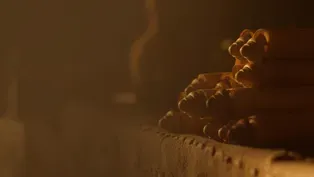
Decoding the Herculaneum Scrolls: AI Meets Ancient Texts
Clip: Season 21 Episode 6 | 3m 34sVideo has Closed Captions
Artificial intelligence is used to find out what some carbonized Herculaneum scrolls say.
Reading the Herculaneum scrolls required multiple scientific steps that started with taking extremely high-resolution X-rays with a photon beam. Next, computer scientist Brent Seales created a deep-learning artificial intelligence program capable of examining the X-rays in minute detail. This examination identified which elements of the image were papyrus and which were ink.
Problems with Closed Captions? Closed Captioning Feedback
Problems with Closed Captions? Closed Captioning Feedback
SECRETS OF THE DEAD is made possible, in part, by public television viewers.

Decoding the Herculaneum Scrolls: AI Meets Ancient Texts
Clip: Season 21 Episode 6 | 3m 34sVideo has Closed Captions
Reading the Herculaneum scrolls required multiple scientific steps that started with taking extremely high-resolution X-rays with a photon beam. Next, computer scientist Brent Seales created a deep-learning artificial intelligence program capable of examining the X-rays in minute detail. This examination identified which elements of the image were papyrus and which were ink.
Problems with Closed Captions? Closed Captioning Feedback
How to Watch Secrets of the Dead
Secrets of the Dead is available to stream on pbs.org and the free PBS App, available on iPhone, Apple TV, Android TV, Android smartphones, Amazon Fire TV, Amazon Fire Tablet, Roku, Samsung Smart TV, and Vizio.
Buy Now

Providing Support for PBS.org
Learn Moreabout PBS online sponsorshipUsing this photon beam to generate extremely high-resolution X-rays of the scrolls is a crucial first ste in trying to read what's inside.
Youre shining an X-ray beam, a very intense X-ray beam, to your object.
It works very similarly to a CT scanner.
Brents theory is that the ink inside the scrolls should reflect more of the X-rays than the paper, allowing him to see a contrast between the ink and the papyrus.
It's a process he's successfully used in the past to read other ancient texts.
In 2015, he was able to read a 2000-year-old carbonized scroll found near Ein Gedi in Israel.
We were the first to ever have done that.
The scroll from Ein Gedi was a verifiable copy of the first two chapters of Leviticus and it was verified by scholars outside my group, biblical scholars, so fully vetted.
Reading inside of the Ein Ged scroll was a major breakthrough.
But the Herculaneum papyr are an even greater challenge.
The scroll for Ein Gedi must have had some metal or impurity in the ink that helped us with the contrast, because it turned out that the writing came directly from the scan.
What we're finding with Herculaneum is that we don't get a direct signal at the ink in the scan.
It has to do with the chemistry in the ancient world, the inks were mainly based on carbon,... and the papyrus is carbon.
So it's kind of hard to see the difference between the background and the foreground.
This came from Paris yesterday Yes.
on the a on the TGV, through the tunnel, right through the...the uh, the English Channel.
Françoise Bérard has brought loose fragments of papyrus from the Paris collection in addition to the Herculaneum papyrus.
They will provide a crucial building block for reading inside the scrolls.
Brent has used his expertise as a computer scientist to build a deep learnin artificial intelligence program to identify where there is ink on the papyrus.
Because the loose fragments contain ink that is visible to the naked eye, they will provide Bren with a sample that can easily be checked to see if the AI is working.
What we're doing when we image the fragments is we're creating a, a scientific control.
Because in the data we capture, we can see what that data looks like, and hopefully tease out what ink actually should be looking like.
Its ok?
Yeah.
Let me a - let me cinch it up with the Allen wrench.
So well do this... Once we use those controls, we have a better sense of what to look for in the data.
So that's where the artificial intelligence comes in.
We've trained a system to be able to see really subtle changes, to go through the data systematically and say, “Does that section look like it has ink?
Yes or no?” It creates for us sort of an amplification.
And the training comes from these open fragments because by being able to see what's visible, we can make this comparison, uh, to what's invisible and hidden.
How Technology Revived Seneca the Elder
Video has Closed Captions
Researcher Valeria Piano discovers long-lost history of Rome written by Seneca the Elder. (2m 53s)
Preview | The Herculaneum Scrolls
Video has Closed Captions
Scientists attempt to read ancient scrolls carbonized by the eruption of Mt. Vesuvius. (31s)
Providing Support for PBS.org
Learn Moreabout PBS online sponsorshipSupport for PBS provided by:
SECRETS OF THE DEAD is made possible, in part, by public television viewers.













